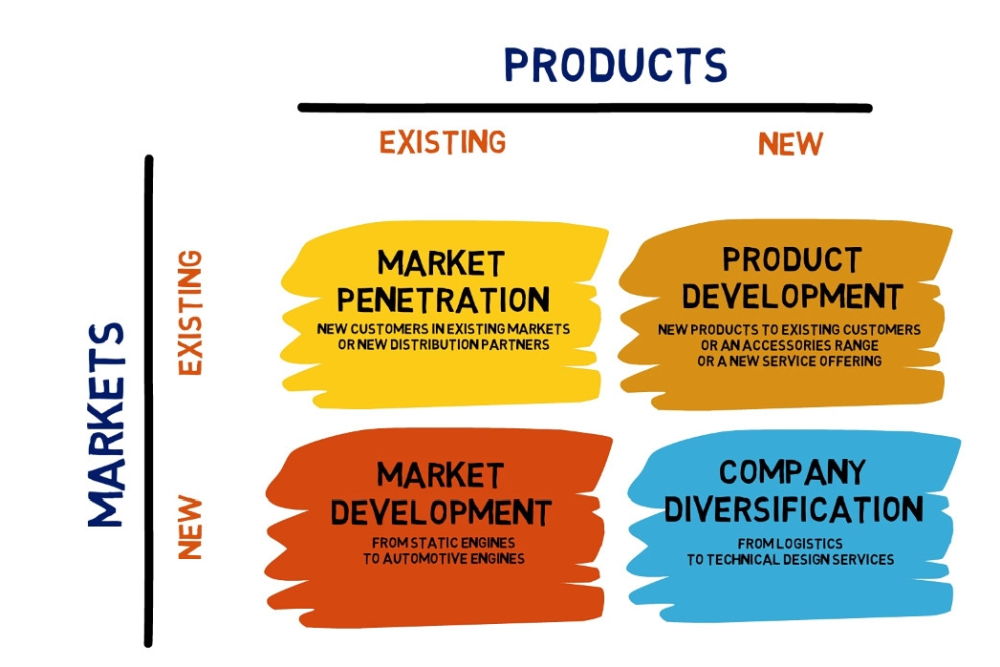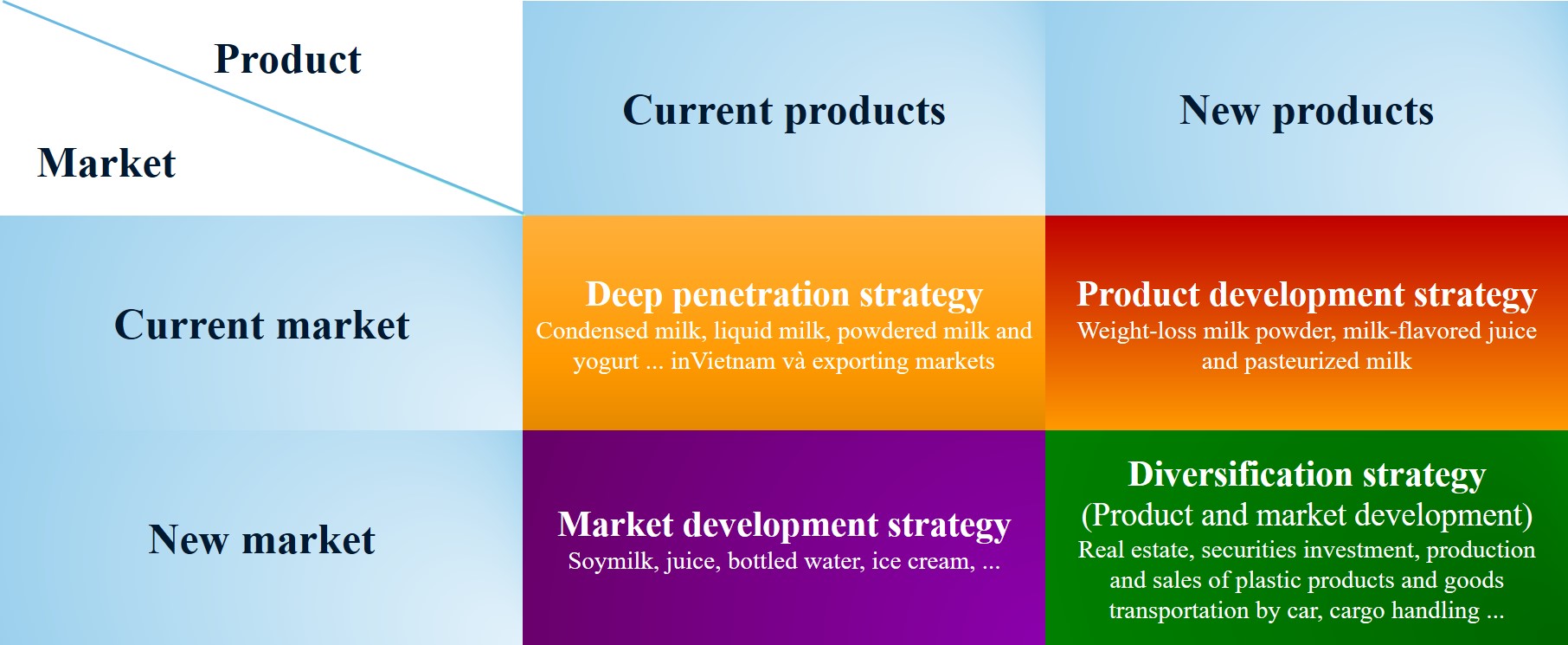The Ansoff matrix or Market Product development matrix, or market product matrix was developed by a famous researcher – Igor Ansoff in 1975. Until now, The Ansoff matrix has been used as a strategic planning tool for revenue growth at firms’ different market segments; thereby facilitating strategic managers in making decisions.
Four growth strategies from Ansoff matrix
Ansoff, in his 1957 paper, provided a definition for product-market strategy as “a joint statement of a product line and the corresponding set of missions which the products are designed to fulfil”. He describes four growth alternatives for growing an organization in existing or new markets, with existing or new products.
Ansoff matrix is built through three steps, namely: (i) identifying current products and markets of enterprise, (ii) identifying new and potential products and markets of enterprise; since then (iii) developing a matrix to determine enterprise’s position and strategic directions of market product pairs. The two criteria of (existing and new) product and (existing and new) market form the two axes of the Ansoff matrix, and shape the four corporate strategy frameworks as shown in the following figure. Each alternative pose differing levels of risk for the firm.

Market penetration strategy or market consolidation strategy
This strategy is applied when enterprises want to expand their business in the current market by using existing products to sell to their existing customers. Specifically, enterprises boost their sales of current products through sustainable marketing efforts in current market, such as discount campaigns, expanding distribution points in the current market, sales, promotions … The four main methods are: increasing purchase frequency, increasing purchase number of existing customers, selling to competitors’ customers, and selling to new customers. For example, Coca-Cola and Pepsi, when penetrating the Vietnamese market in the early 2000s, conducted their marketing campaigns and aggressive promotions to dominate the market, in which Coca-Cola focused on the North and Pepsi in the South.
Market development strategy
This strategy includes the activities to promote sales of current products in new markets, such as new areas or new countries. New markets can also be interpreted as new market shares with products that have been adapted or new distribution channels.
The difference between market development strategy and market penetration strategy is the expansion in overall market size of enterprises. For example, Coca-Cola brings its products to Russia for sale, which means it has expanded its markets and increased its potential market.
However, market development strategy has certain risks due to the lack of knowledge about the needs and tastes of new customers. For example, a US supermarket brand decides to use the market development strategy in Japan by building large supermarkets, which are very successful models in the US. However, this is a mistake because Japanese consumers do not like American style shopping. Thus, this brand does not really understand the shopping culture of the Japanese people, although they have very extensive knowledge of industrial management methods.
Product development strategy
This is a strategy to increase revenue by launching new products to the current market. New products can be changed in style, design, new version, … and sold to customers through existing distribution channels. As market penetration strategy, market development strategy can cause risks such as leaving original brand, or original brand removal with new brand appearance.
There are three main ways to implement this strategy depending on whether enterprise wants a new brand name for this product. They are: products with new features, quality and technology but no new brand names; or expanding brand with a new brand name; and finally, new brand name with its own identity. For example, Coca-Cola has removed calories in its beverage component to create Diet Coke, and adds vanilla flavor to create Vanilla Coke.
Diversification strategy
For this strategy, enterprises try to introduce and develop their new products in new markets. This is considered a campaign with many risks because enterprises must develop both new markets and new products at the same time. The risk that enterprises can face is that their new brand can lose the meaning of the original brand, or manipulate the original brand. Or sometimes, the lack of knowledge about consumers’ tastes and habits makes this strategy fail.
Product diversification strategy is only implemented when enterprises recognize potential needs in addition to their current products. This strategy can develop vertical activities, which make the most of existing management technology devices, such as selling sales software, then hardware devices such as printers, computer, … Or, it is also possible to develop a horizontal strategy for satisfying customers in other field or with other technologies, for example, selling sales software and repairing printers, assembling computers, ….
Analyzing some practical examples
Ansoff matrix of Coca-Cola.
Coca-Cola is a freshwater brand registered in 1893 in the United States. According to the history of development, Ansoff matrix can be applied to analyze the business development strategy of Coca-Cola as follows:

Concerning the Market penetration strategy, with its traditional products developed since 1886, Coca-Cola had penetrated deep into the market, its targeting customers are large buyers and multinational business organizations.
Concerning the Market development strategy, after achieving great success in the US, Coca-Cola decided to expand its market to the UK with vanilla flavored products. Previously, Coca-Cola conducted a survey about Russian customers’ tastes as well as products with the same flavor in this market for launching completely distinctive products but still bearing its style.
Concerning Product development strategy: Coca-Cola has constantly changed and developed its products. So far, this company has launched many new products to the market, such as diet drinks (Diet Coke), Vanilla Coke with vanilla flavor, or changing the design and size of Coca-Cola bottles to suitable for more customer groups.
Concerning the Diversification strategy: Coca-Cola has produced energy drinks for sports players. In addition, the company has produced snacks served with its beverages.
Ansoff matrix of Vinamilk – a Vietnamese milk company
Vinamilk has penetrated deeply into the existing markets by expanding the distribution system of existing products such as condensed milk, liquid milk, powdered milk and yogurt … in all provinces with 220 distributors and 125,000 points of sales. In addition, the company has exported its products to foreign markets such as Australia, Cambodia, the Philippines, the US, …

Vinamilk’s new product and service development strategy has aimed at new product lines, such as weight-loss milk powder, milk-flavored juice and pasteurized milk with various flavors such as strawberry, chocolate, sugar, rich in calcium, …
Vinamilk has developed the market by adding new products to the existing markets, such as soymilk, juice, bottled water, ice cream, … for diversifying customers and market segment.
Also, for developing existing markets and products, Vinamilk has expanded its business activities to look for its business development opportunities. Currently, Vinamilk has participated in real estate, securities investment, production and sales of plastic products and goods transportation by car, cargo handling …
Conclusion
Ansoff Matrix is one of the first and effective tools to support strategic managers for clearly defining strategic position of their enterprises, thereby establishing future directions and objectives. At the same time, Ansoff Matrix shows risks of each strategy in the decision-making process. However, this model is rather simple because it does not integrate with external environment elements. Moreover, the model focuses on potential market rather than necessary resources to support the chosen strategy. In addition, there is no guarantee of success when enterprises follow a specific strategy, so it is recommended to combine this model with other models or in-depth studies to properly assess their current situation. Since then, enterprises can choose the most suitable direction in the future.
Source: Ansoff Igor (1957), “Strategies for Diversification”, Harvard Business Review, Vol. 35 Issue 5, pp. 113-124.

1 May 2020